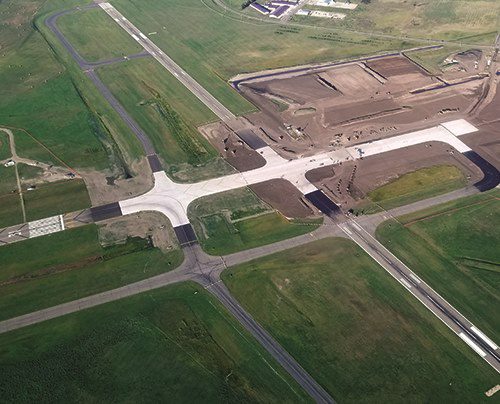There were plenty of factors that could have forced Bismarck Airport (BIS) to shut down while crews replaced its 8,794-foot main runway: an unusually high water table, the diverse needs of five different air carriers and a construction schedule heavily influenced by funding. Despite these challenges and an early winter snowstorm, the North Dakota airport managed to remain open for traffic throughout the $64 million project. When airport officials started planning the project with engineering consultant KLJ, the FAA indicated it would need to deliver funding over three years.
There were plenty of factors that could have forced Bismarck Airport (BIS) to shut down while crews replaced its 8,794-foot main runway: an unusually high water table, the diverse needs of five different air carriers and a construction schedule heavily influenced by funding. Despite these challenges and an early winter snowstorm, the North Dakota airport managed to remain open for traffic throughout the $64 million project.

“We did not want to see our community lose access to the national airspace system while the runway was being reconstructed,” says Airport Director Greg Haug.
Runway 13-31, originally built in the1950s, had been maintained as well as possible but was far beyond its useful life, he explains. During the course of the full-length, full-width replacement that concluded in October 2019, BIS also made the change from asphalt to concrete pavement for greater longevity and decreased maintenance costs.
When airport officials started planning the project with engineering consultant KLJ, the FAA indicated it would need to deliver funding over three years.
|
Project: Runway Reconstruction Location: Bismarck (ND) Airport Owner: City of Bismarck Cost: $64 million Funding: 70% FAA; 25% city of Bismarck; 5% North Dakota Aeronautics Commission Construction: June 2017 to October 2019 Carriers Affected: Allegiant; American Airlines; Delta Air Lines; Frontier Airlines; United Airlines Engineering Consultant: KLJ Engineering LLC Construction Contractors: Strata Corp. (Phases 1 & 2); Northern Improvement Co. (Phase 3) Electrical Contractors: Edling Electric (Phase 1); Strata Corp. (Phases 2 & 3) Geogrid Systems: Tensar BX1200 (Phase 1); Thrace Linq TLG-12 (Phase 2); Tensar BX Type 2F (Phase 3) LED High-Intensity Runway Lighting: ADB SAFEGATE Airfield Signage: ADB SAFEGATE Pavement Sensors: Vaisala Awards: Construction contractor Strata Corp earned back-to-back Gold awards for concrete work from the North Dakota Ready Mix & Concrete Products Assoc. |
“We had to break out the phasing based on what we knew about funding,” says KLJ Project Manager Tom Neigum.
The first phase of the project started in summer 2017 and focused on the first 2,200 feet of the runway’s south end, with work extending through the intersection of the crosswind runway. This required BIS to temporarily shorten the main runway to three different lengths, ranging from 5,450 feet to 7,050 feet. Most aircraft operations were able to continue as usual. Phase 1 cost approximately $25 million to complete.
The second phase, which also cost about $25 million, reconstructed the next 5,500 feet from just north of the crosswind runway toward the north end of the main runway. Work ran from spring to fall in 2018 and required the airport users to operate on the 6,600-foot crosswind Runway 03-21.
During Phase 3, crews replaced 1,100 feet on the north segment for $14 million. An unseasonably early snowstorm in October 2019 dumped 16 inches of snow on Bismarck and caused the final phase to extend past the deadline about one week.
Funding for the $64 million project came from three sources: the FAA, the North Dakota Aeronautics Commission and the airport itself, which is run by the city of Bismarck. (For more details about the funding process, see sidebar on Page 14.)
Years in the Making
The origins of the project date back to 2011, when BIS had KLJ conduct a geotechnical evaluation of the pavement. The report revealed that the transverse cracks were so bad that pavement on either side of the main crack was also cracking and hinging, with pavement on both sides dropping lower and lower. Core samples of the runway confirmed the composition of the many different pavement sections from one end to the other, varying from 9 inches with a gravel base to 22 inches on top of dirt with no gravel base. The consulting engineer’s report also revealed that groundwater was causing problems underneath the pavement and heaving during freeze/thaw cycles.
Haug and his team knew the runway would soon need substantial upgrades due to its declining condition and advanced age. Initially, they thought a 4- to 6-inch mill and overlay would be needed. However, as planning for a mill-and-overlay fix progressed, it became apparent that the problem was worse. The longitudinal and transverse cracking and differential movement of the pavement was progressing at a much faster pace than expected, explains Haug.
In 2014, a significant amount of foreign object debris on the pavement made it imperative for BIS to do something to keep the runway safe and operational. As airport leaders worked with FAA to justify a complete reconstruction of the runway, they settled on a “keel project” that proceeded with a 4-inch mill and overlay of the center 60 to 75 feet—the section in the worst condition. This allowed the airport to improve safety until funds became available for a complete runway reconstruction.
Water Table Issues
The pavement section was a major challenge for the design team. Knowing that the airfield’s groundwater was only a few feet under the surface, the big question was: What would hold up to North Dakota’s grueling temperature extremes, which can range from -40 to 110 degrees Fahrenheit?
Ultimately, KLJ settled on a 59-inch section that provided partial frost protection. Full frost protection would have required a more costly 72-inch pavement section. In addition, the design added a drain tile system to remove groundwater from underneath the new pavement.
The airport and KLJ also secured approval from the FAA to utilize 12 inches of recycled asphalt millings at the bottom of the pavement section and on top of a geogrid material instead of following the standard practice of scarifying and recompacting the bottom 12 inches of soil. This created a very stable construction platform to build upon, explains Neigum.
On top of that, crews installed a geotextile fabric, 17 inches of subbase, 8 inches of imported crushed aggregate base course, 6 inches of cement-treated base course and 16 inches of concrete pavement to top it off.
“Having the geogrid and the 12 inches of recycled asphalt millings was the saving grace for us,” Neigum reflects. “If the FAA had told us we had to construct it the traditional way [recompacting], I’m not sure we would have been able to meet compaction requirements and construct the pavement section with our limited construction season.”

In order to meet FAA standards for the crushed aggregate, the contractor imported aggregate from Minnesota and Montana. Haug notes that the airport tried to source material from local vendors to keep costs down, but the quality of aggregate in the Bismarck region does not meet stringent FAA requirements.
New Practices
Switching from asphalt to concrete runway pavement is requiring the airport to change some of its snow and ice control practices.
One issue is that concrete reacts to winter weather differently than asphalt. In particular, asphalt absorbs heat better, and consequently burns off more snow and ice as it heats up. Since concrete does not share this characteristic, BIS will need more deicer to maintain the runway during winters. The airport has prepared for the upcoming winter season by stocking an additional 10,000 to 15,000 gallons of pavement deicing chemicals to keep planes flying on schedule.
Haug considers the additional cost for deicer miniscule compared to the ongoing repairs and maintenance that asphalt requires.
He and other airport leaders know that winters will be forever different for BIS snow removal crews, but they are confident that the advantages of concrete will outweigh the advantages of asphalt.
Coordination Was Key
Haug notes it was fairly complicated to work with air carriers throughout the project, because it included numerous changes to the usable lengths of both the main and crosswind runways, especially during the first phase. But maintaining adequate runway length for airline operations was crucial.
During Phase 1, the useble runway and length changed three times. For six weeks, the main runway was 5,450 feet and accommodated general aviation aircraft, while the airlines used the 6,600-foot crosswind runway. For the next 10 weeks, the main runway had 6,300 feet of usable length and accommodated all traffic while the crosswind runway was closed for intersection work. The last four weeks of the first phase had all traffic on 7,050 feet of the main runway.
“The airlines were really good to us during all phases of the construction,” Haug reports. “They changed equipment as much as they could and/or needed to in order to keep our service alive.”
Haug credits Assistant Airport Director Tim Thorsen for managing coordination between the project team and the five different airlines that serve BIS. Informing all stakeholders about the construction schedule long before shovels hit dirt was especially important, he emphasizes.
“We started talking with the airlines about a year ahead of groundbreaking,” Thorsen recalls. “As we got closer to construction, we started sending diagrams and emails every month with updates. So they ended up using airplane types that would be compatible with the runways we had available.”
Project Within a Project
Working through the details of airfield work that would affect FAA services and equipment was another complicating factor.
 “It was like a project within a project,” Thorsen relates. “The FAA is fastidious with its requirements, so we worked with them back and forth to get what was needed. We wanted to figure out what would work for us and meet the FAA requirements.”
“It was like a project within a project,” Thorsen relates. “The FAA is fastidious with its requirements, so we worked with them back and forth to get what was needed. We wanted to figure out what would work for us and meet the FAA requirements.”
The FAA and airport entered into four reimbursable agreements: two for flight checks of the new runway, one for the repair, replacement or relocation of FAA equipment, and another for planning.
“Obviously they were involved in the project all along,” Haug says. “We had meetings with them monthly as it was progressing over the course of three years, and they noted that there was going to be impact.”
For example, crews had to lower the main cable running underneath the runway from the air traffic control tower to the airport surveillance radar because the horizontal profile of the new runway changed according to current FAA design standards—as much as 5 feet in some areas. New cables were bored in and pulled through the conduit underneath the runway at a deeper depth, and new splice boxes were installed on both sides of the runway.
The project also required modifications to the safety areas of the instrument landing systems on both ends of the runway.

Other FAA-related work included the installation of new foundations for the medium-intensity approach light system with runway alignment indicator lights (MALS-R).
Haug explains that the FAA wanted the safety areas around the new runway to be “as smooth as slate on a pool table.” This required a great deal of dirt work on both ends of the runway.
FAA inspectors were onsite throughout construction. FAA charged its fees against a reimbursable account for all costs for work involving the agency’s assets. At the end of each phase, FAA personnel inspected the job, and BIS turned ownership of the equipment back to the agency.
“This runway has been in place a long time, and it was designed under an old criterion,” Thorsen says. “We rebuilt it to bring it up to today’s standards.”
“We’re glad to have this project behind us,” Haug reflects. “It was a challenge to design, construct and finance. We’re thankful for all the men and women who played a part in it”.
|
Riding the Federal Funding Rollercoaster The original cost estimate for a complete reconstruction of the 8,794-foot main runway at Bismarck Airport (BIS) was $70 million. That left Airport Director Greg Haug in a lurch because at the time, FAA could only commit to paying for 53% of the cost even though the project qualified for 90% funding. That inspired the project team to embark on a series of design changes that brought the cost down to $67 million before finally going out for bids—still a lofty sum for BIS to cover the balance of, notes Haug. However, through a series of fortunate events and fortuitous timing, FAA wound up covering about 70% of the costs. Since BIS bid the project in three phases, work for the final phase of construction was being bid just as Congress passed a $1 billion supplemental funding program for airport infrastructure projects, which was distributed as Airport Improvement Program discretionary grants. Among other things, projects had to be “shovel-ready” (bids in hand, ready to begin) and highly visible to qualify. The full-length reconstruction of Runway 13-31, already through its first two phases, met all the requirements, and BIS was one of 37 U.S. airports to receive money from the first wave of supplementary funding. In fact, the $9.7 million grant BIS received was the sixth-largest that was awarded in the first round. “It was a funding kicker for us, and it helped us with the overall cost of our project,” Haug remarks. “When we looked at the requirements and the type of timeframe for this program, we realized we met every single requirement with our runway project. It couldn’t have been better for us.” In the end, FAA covered 70% of runway project, the city of Bismarck paid 25%, and the state of North Dakota covered 5%—much better than the 53/47 split the airport originally faced. “Reaching that 70% mark was a godsend,” Haug recalls. After all the ups and downs of the funding process, BIS leaders had everything they wanted for the new runway…except upgraded lighting. The one aspect of the project not approved by the FAA was LED high-intensity runway lights. But that, too, worked out. And excellent timing again played a major role. While working on the original design for the overall project, Haug and Assistant Airport Director Tim Thorsen caught wind that LED lighting might be approved down the road. So they saved that portion of the work for the third phase of construction, and had crews reinstall the existing incandescent runway lighting in the meantime. As luck would have it, the FAA approved LED high-intensity runway lights for funding just after the airport bid out its third phase. At that point, FAA allowed BIS to change order the LED lights into the project. However, the new LED lighting material wasn’t scheduled to arrive until mid-winter. Because North Dakota’s winters have been known to start as early as October, the airport opted to reinstall its incandescent lights and replace them with LEDs in spring 2020. Haug reports that the new airfield lights were worth the wait. Despite costing more than incandescent lights, LED equivalents reduce the daily electric use for the runway lighting systems and also require far less maintenance. Given the massive snowfalls the area can receive, BIS opted to use 30-inch light stems, the tallest allowed by FAA. |


 facts&figures
facts&figures

